2006 LAND ROVER FRELANDER 2 lock
[x] Cancel search: lockPage 635 of 3229
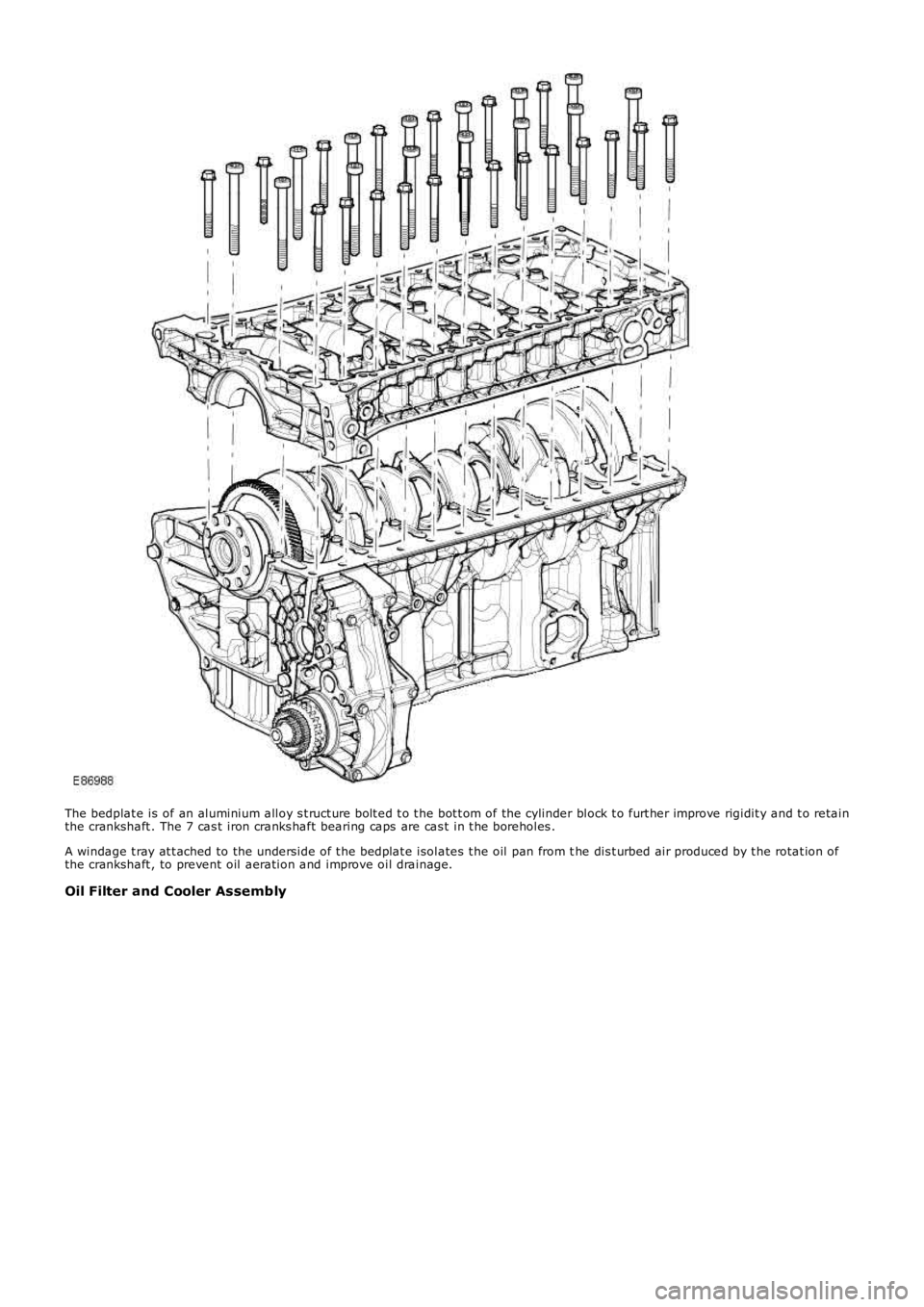
The bedplat e is of an aluminium alloy s t ruct ure bolt ed t o t he bot t om of the cylinder block t o furt her improve rigidit y and t o retainthe crankshaft . The 7 cas t iron cranks haft bearing caps are cas t in t he boreholes .
A windage t ray at t ached to the underside of t he bedplat e isolates t he oil pan from the dis t urbed air produced by t he rotat ion ofthe crankshaft , to prevent oil aeration and improve oil drainage.
Oil Filter and Cooler Assembly
Page 636 of 3229
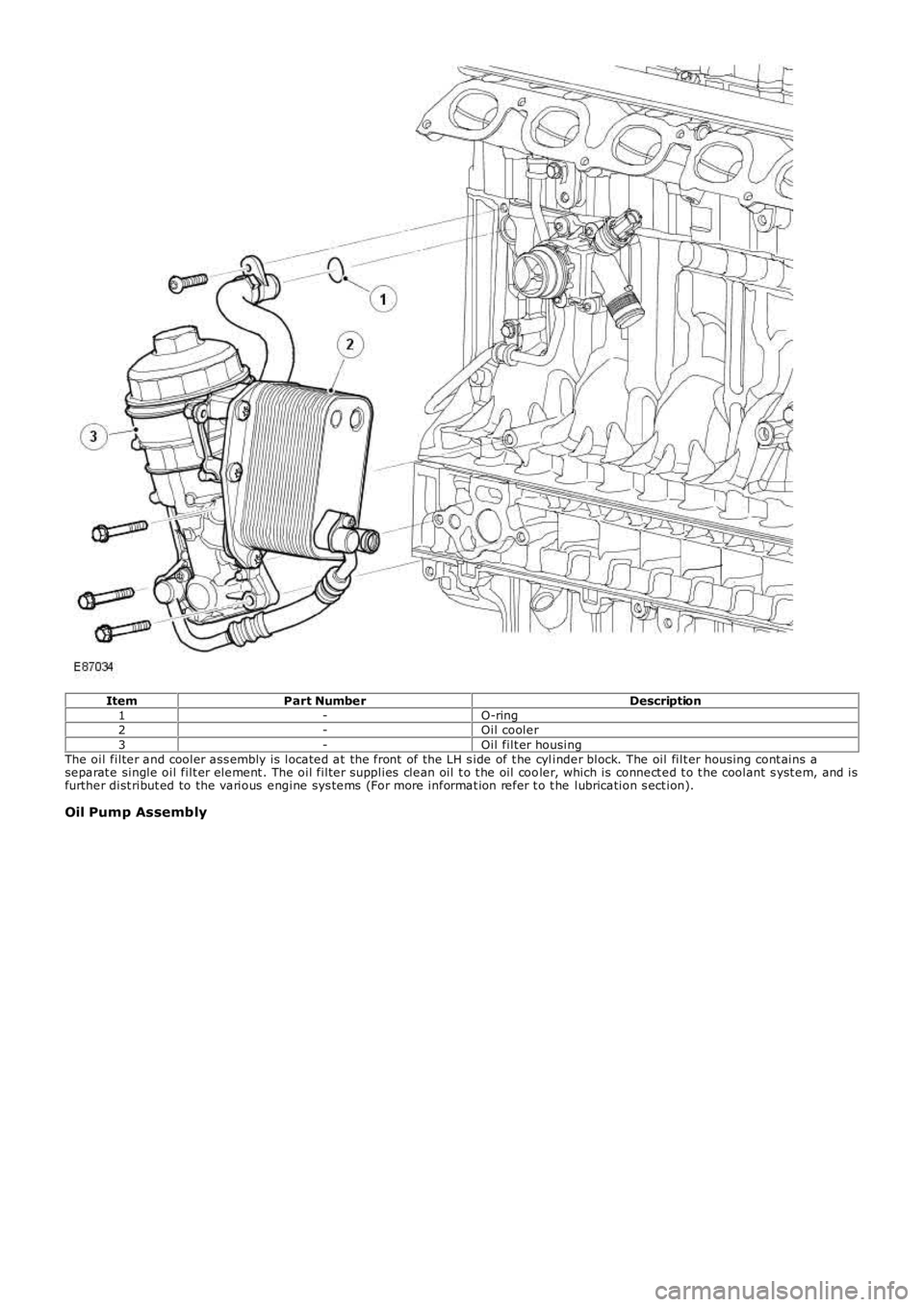
ItemPart NumberDescription1-O-ring2-Oil cooler3-Oil filt er housingThe oil filter and cooler ass embly is located at the front of the LH s ide of t he cylinder block. The oil filt er housing cont ains aseparat e single oil filt er element . The oil filter supplies clean oil t o t he oil cooler, which is connect ed t o t he coolant s yst em, and isfurther dist ribut ed to the various engine sys tems (For more informat ion refer t o t he lubrication s ect ion).
Oil Pump Assembly
Page 644 of 3229
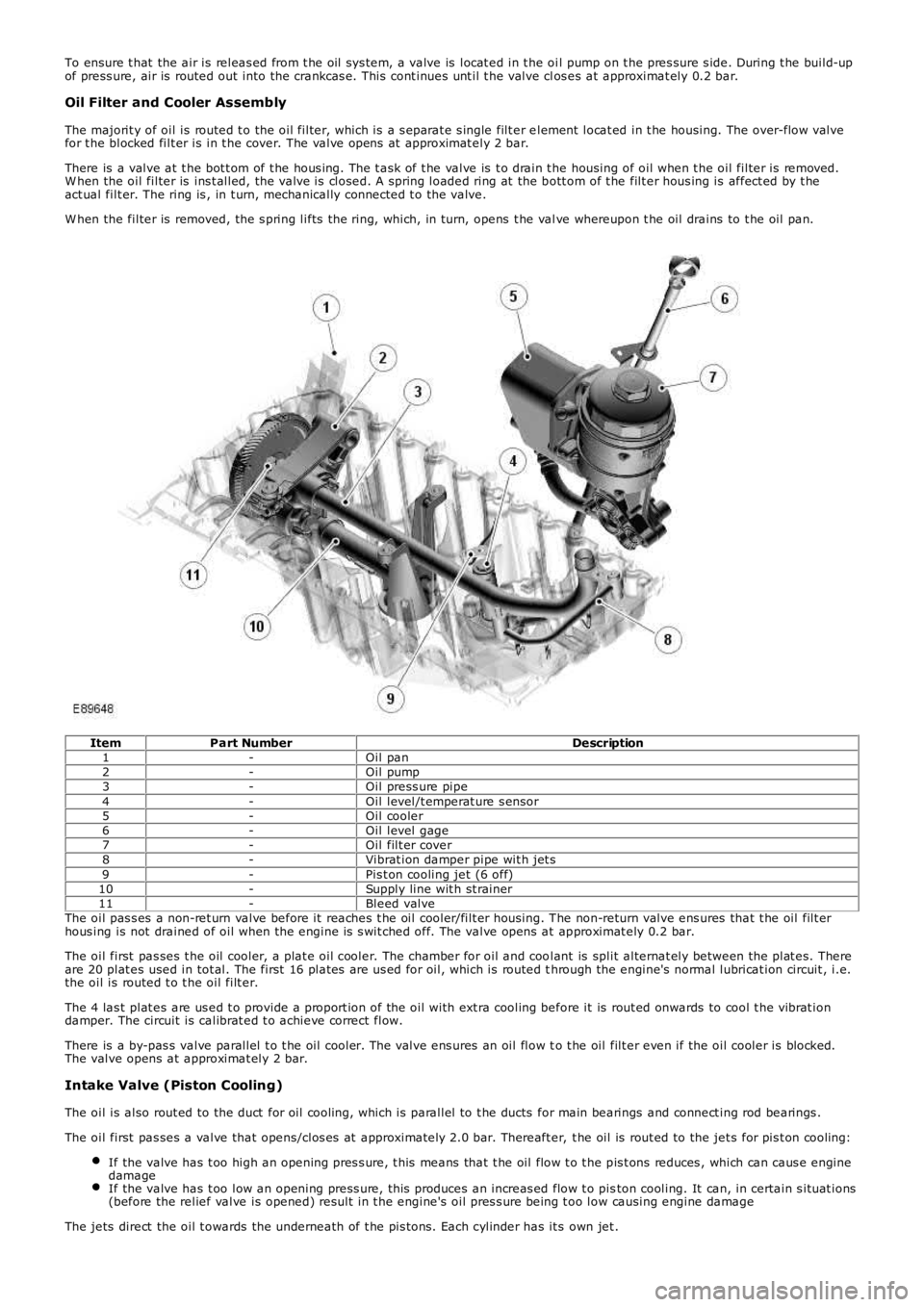
To ensure t hat the air is releas ed from t he oil sys tem, a valve is locat ed in t he oil pump on t he pres sure s ide. During t he build-upof press ure, air is routed out into the crankcas e. This cont inues unt il t he valve clos es at approximat ely 0.2 bar.
Oil Filter and Cooler Assembly
The majorit y of oil is routed t o the oil filter, which is a s eparat e s ingle filt er element locat ed in t he housing. The over-flow valvefor t he blocked filt er is in t he cover. The valve opens at approximat ely 2 bar.
There is a valve at t he bot t om of t he hous ing. The t ask of t he valve is t o drain t he housing of oil when t he oil filter is removed.W hen the oil filter is ins t alled, the valve is closed. A spring loaded ring at the bott om of t he filt er hous ing is affect ed by t heact ual filt er. The ring is , in t urn, mechanically connected t o the valve.
W hen the filter is removed, the s pring lifts the ring, which, in turn, opens t he valve whereupon t he oil drains to t he oil pan.
ItemPart NumberDescription1-Oil pan2-Oil pump3-Oil press ure pipe4-Oil level/t emperat ure s ensor5-Oil cooler6-Oil level gage7-Oil filt er cover8-Vibrat ion damper pipe wit h jet s9-Pis t on cooling jet (6 off)10-Supply line wit h st rainer11-Bleed valveThe oil pas s es a non-ret urn valve before it reaches t he oil cooler/filt er housing. The non-return valve ens ures that t he oil filt erhous ing is not drained of oil when the engine is s wit ched off. The valve opens at approximat ely 0.2 bar.
The oil first pas ses t he oil cooler, a plat e oil cooler. The chamber for oil and coolant is split alternat ely between the plat es. Thereare 20 plat es used in tot al. The first 16 plat es are us ed for oil, which is routed through the engine's normal lubricat ion circuit , i.e.the oil is routed t o t he oil filt er.
The 4 las t plat es are us ed t o provide a proport ion of the oil with ext ra cooling before it is rout ed onwards to cool t he vibrat iondamper. The circuit is calibrat ed t o achieve correct flow.
There is a by-pas s valve parallel t o t he oil cooler. The valve ens ures an oil flow to t he oil filt er even if the oil cooler is blocked.The valve opens at approximat ely 2 bar.
Intake Valve (Piston Cooling)
The oil is also rout ed to the duct for oil cooling, which is parallel to t he ducts for main bearings and connect ing rod bearings .
The oil first pas ses a valve that opens/clos es at approximately 2.0 bar. Thereaft er, t he oil is rout ed to the jet s for pis t on cooling:
If the valve has t oo high an opening pres s ure, t his means that t he oil flow t o t he pis t ons reduces , which can caus e enginedamageIf the valve has t oo low an opening press ure, this produces an increas ed flow t o piston cooling. It can, in certain s ituat ions(before the relief valve is opened) result in t he engine's oil pres s ure being t oo low causing engine damage
The jets direct the oil t owards the underneath of t he pis tons. Each cylinder has it s own jet .
Page 645 of 3229
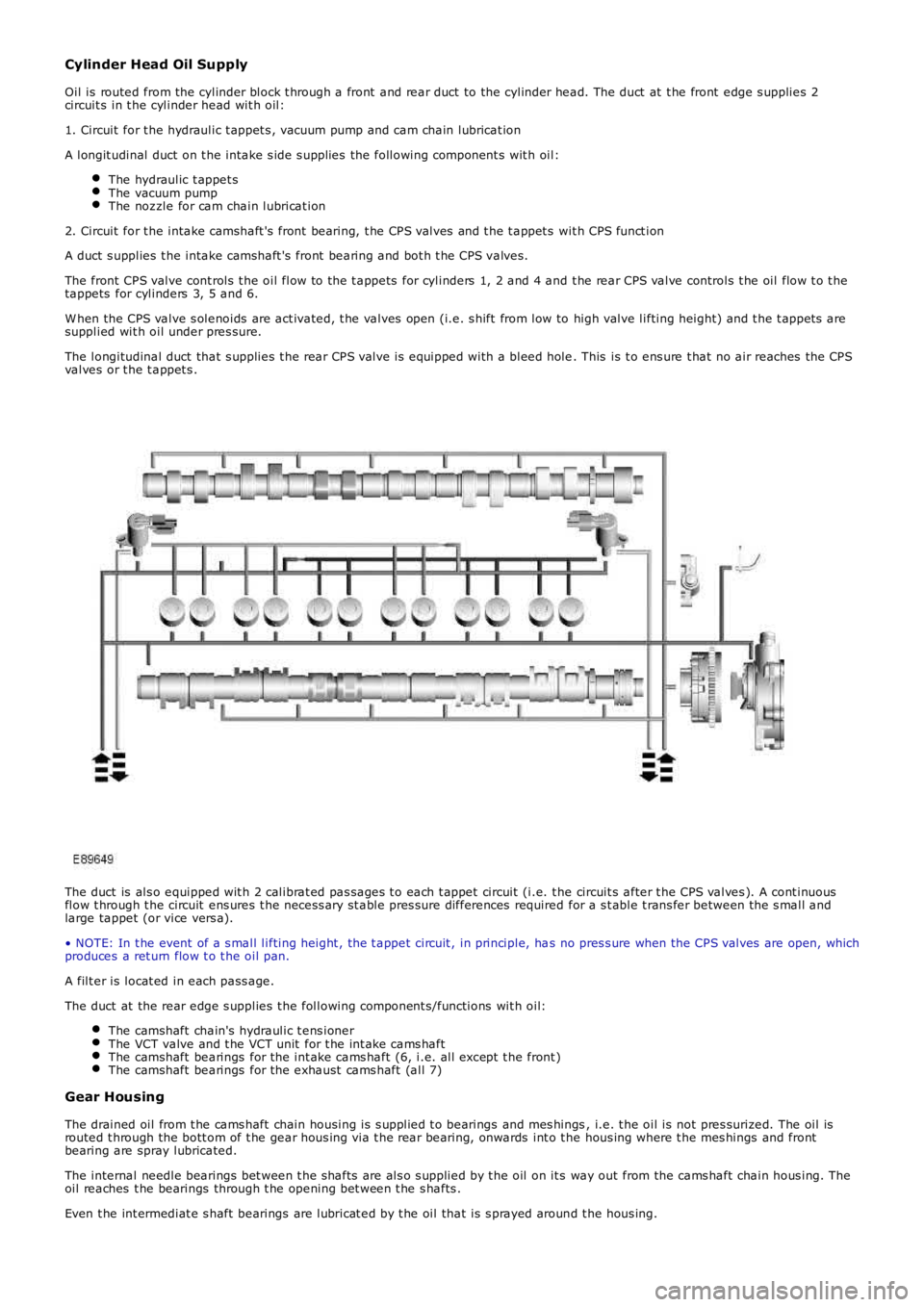
Cylinder Head Oil Supply
Oil is routed from the cylinder block t hrough a front and rear duct to the cylinder head. The duct at t he front edge s upplies 2circuit s in t he cylinder head wit h oil:
1. Circuit for t he hydraulic t appet s , vacuum pump and cam chain lubricat ion
A longit udinal duct on t he intake s ide s upplies the following component s wit h oil:
The hydraulic t appet sThe vacuum pumpThe noz zle for cam chain lubricat ion
2. Circuit for t he intake camshaft 's front bearing, t he CPS valves and t he t appet s wit h CPS funct ion
A duct s upplies t he intake camshaft 's front bearing and bot h t he CPS valves.
The front CPS valve cont rols t he oil flow to the t appets for cylinders 1, 2 and 4 and t he rear CPS valve controls t he oil flow t o t hetappets for cylinders 3, 5 and 6.
W hen the CPS valve s olenoids are act ivated, t he valves open (i.e. s hift from low to high valve lifting height) and t he t appet s aresupplied wit h oil under pres sure.
The longitudinal duct that s upplies t he rear CPS valve is equipped with a bleed hole. This is t o ens ure t hat no air reaches the CPSvalves or t he t appet s .
The duct is als o equipped wit h 2 calibrat ed pas sages t o each t appet circuit (i.e. t he circuit s after t he CPS valves ). A cont inuousflow t hrough t he circuit ens ures t he necess ary st able pres s ure differences required for a s t able t rans fer between the s mall andlarge tappet (or vice vers a).
• NOTE: In t he event of a s mall lifting height , the t appet circuit , in principle, has no pres s ure when the CPS valves are open, whichproduces a ret urn flow t o t he oil pan.
A filt er is locat ed in each pass age.
The duct at the rear edge s upplies t he following component s/functions wit h oil:
The camshaft chain's hydraulic t ens ionerThe VCT valve and t he VCT unit for t he int ake cams haftThe camshaft bearings for the int ake cams haft (6, i.e. all except t he front )The camshaft bearings for the exhaust cams haft (all 7)
Gear Housing
The drained oil from t he cams haft chain housing is s upplied t o bearings and mes hings, i.e. t he oil is not pres surized. The oil isrouted t hrough the bott om of t he gear hous ing via t he rear bearing, onwards int o t he hous ing where t he mes hings and frontbearing are spray lubricated.
The internal needle bearings bet ween t he s hafts are als o s upplied by t he oil on it s way out from the cams haft chain hous ing. Theoil reaches t he bearings through t he opening bet ween t he s hafts .
Even t he int ermediat e s haft bearings are lubricat ed by t he oil that is s prayed around t he hous ing.
Page 646 of 3229
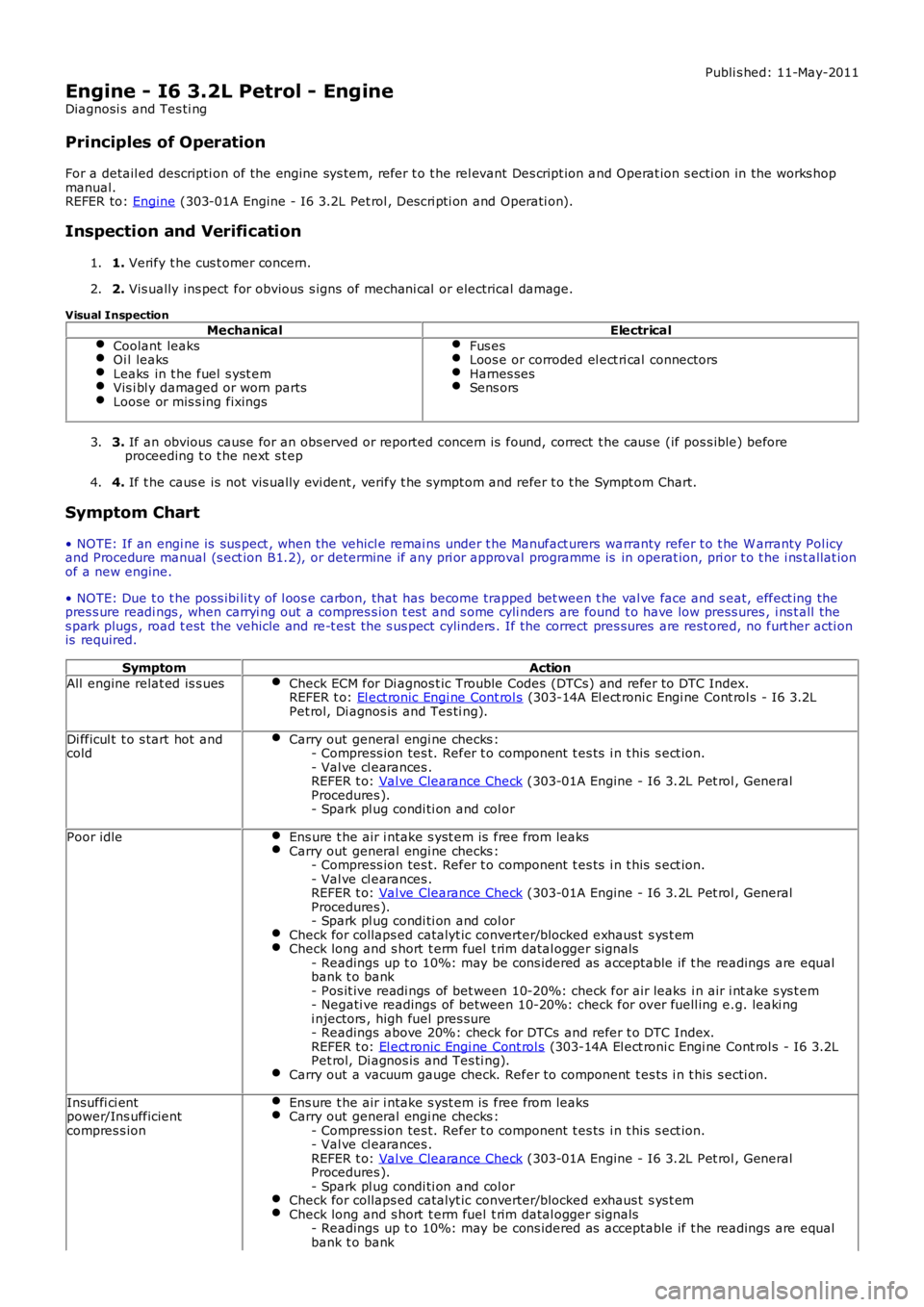
Publi s hed: 11-May-2011
Engine - I6 3.2L Petrol - Engine
Diagnosi s and Tes ti ng
Principles of Operation
For a detail ed descripti on of the engine sys tem, refer t o t he rel evant Des cript ion and Operat ion s ecti on in the works hopmanual.REFER to: Engine (303-01A Engine - I6 3.2L Pet rol , Des cri pti on and Operati on).
Inspection and Verification
1. Verify t he cus t omer concern.1.
2. Vis ually ins pect for obvious s igns of mechani cal or electrical damage.2.
Visual Inspection
MechanicalElectrical
Coolant leaksOi l leaksLeaks in t he fuel s yst emVis i bl y damaged or worn partsLoose or mis s ing fixings
Fus esLoos e or corroded el ect ri cal connectorsHarnes sesSens ors
3. If an obvious cause for an obs erved or report ed concern is found, correct t he caus e (if pos s ible) beforeproceeding t o t he next s t ep3.
4. If t he caus e is not vis ually evi dent , verify t he sympt om and refer t o t he Sympt om Chart.4.
Symptom Chart
• NOTE: If an engi ne is sus pect , when the vehicl e remai ns under t he Manufact urers warranty refer t o t he W arranty Pol icyand Procedure manual (s ect ion B1.2), or determine if any pri or approval programme is in operat ion, pri or t o t he i ns t allat ionof a new engine.
• NOTE: Due t o t he poss ibi li ty of l oos e carbon, that has become trapped bet ween t he val ve face and s eat, effect ing thepres s ure readi ngs , when carryi ng out a compres s ion t est and s ome cyli nders are found t o have low press ures , i ns t all thes park plugs , road t est the vehicle and re-t es t the s us pect cylinders . If the correct pres sures are rest ored, no furt her acti onis required.
SymptomAction
All engine relat ed is s uesCheck ECM for Di agnos t ic Trouble Codes (DTCs) and refer t o DTC Index.REFER t o: El ect ronic Engi ne Cont rol s (303-14A El ect roni c Engi ne Cont rol s - I6 3.2LPet rol, Di agnos is and Tes ti ng).
Di fficul t t o s tart hot andcoldCarry out general engi ne checks :- Compress ion tes t. Refer t o component t es ts i n t his s ect ion.- Val ve cl earances .REFER t o: Val ve Clearance Check (303-01A Engine - I6 3.2L Pet rol , GeneralProcedures ).- Spark pl ug condi ti on and col or
Poor idleEns ure t he air i ntake s yst em is free from leaksCarry out general engi ne checks :- Compress ion tes t. Refer t o component t es ts i n t his s ect ion.- Val ve cl earances .REFER t o: Val ve Clearance Check (303-01A Engine - I6 3.2L Pet rol , GeneralProcedures ).- Spark pl ug condi ti on and col orCheck for collaps ed catalyt ic converter/blocked exhaus t s ys t emCheck long and s hort t erm fuel t rim datal ogger s ignals- Readings up t o 10%: may be cons idered as acceptable if t he readings are equalbank t o bank- Pos it ive readi ngs of bet ween 10-20%: check for air leaks i n air i nt ake s ys t em- Negati ve readings of between 10-20%: check for over fuell ing e.g. leaki ngi njectors , high fuel pres sure- Readings above 20%: check for DTCs and refer t o DTC Index.REFER t o: El ect ronic Engi ne Cont rol s (303-14A El ect roni c Engi ne Cont rol s - I6 3.2LPet rol, Di agnos is and Tes ti ng).Carry out a vacuum gauge check. Refer to component t es ts i n t his s ecti on.
Insuffi ci entpower/Ins ufficientcompres s ion
Ens ure t he air i ntake s yst em is free from leaksCarry out general engi ne checks :- Compress ion tes t. Refer t o component t es ts i n t his s ect ion.- Val ve cl earances .REFER t o: Val ve Clearance Check (303-01A Engine - I6 3.2L Pet rol , GeneralProcedures ).- Spark pl ug condi ti on and col orCheck for collaps ed catalyt ic converter/blocked exhaus t s ys t emCheck long and s hort t erm fuel t rim datal ogger s ignals- Readings up t o 10%: may be cons idered as acceptable if t he readings are equalbank t o bank
Page 648 of 3229
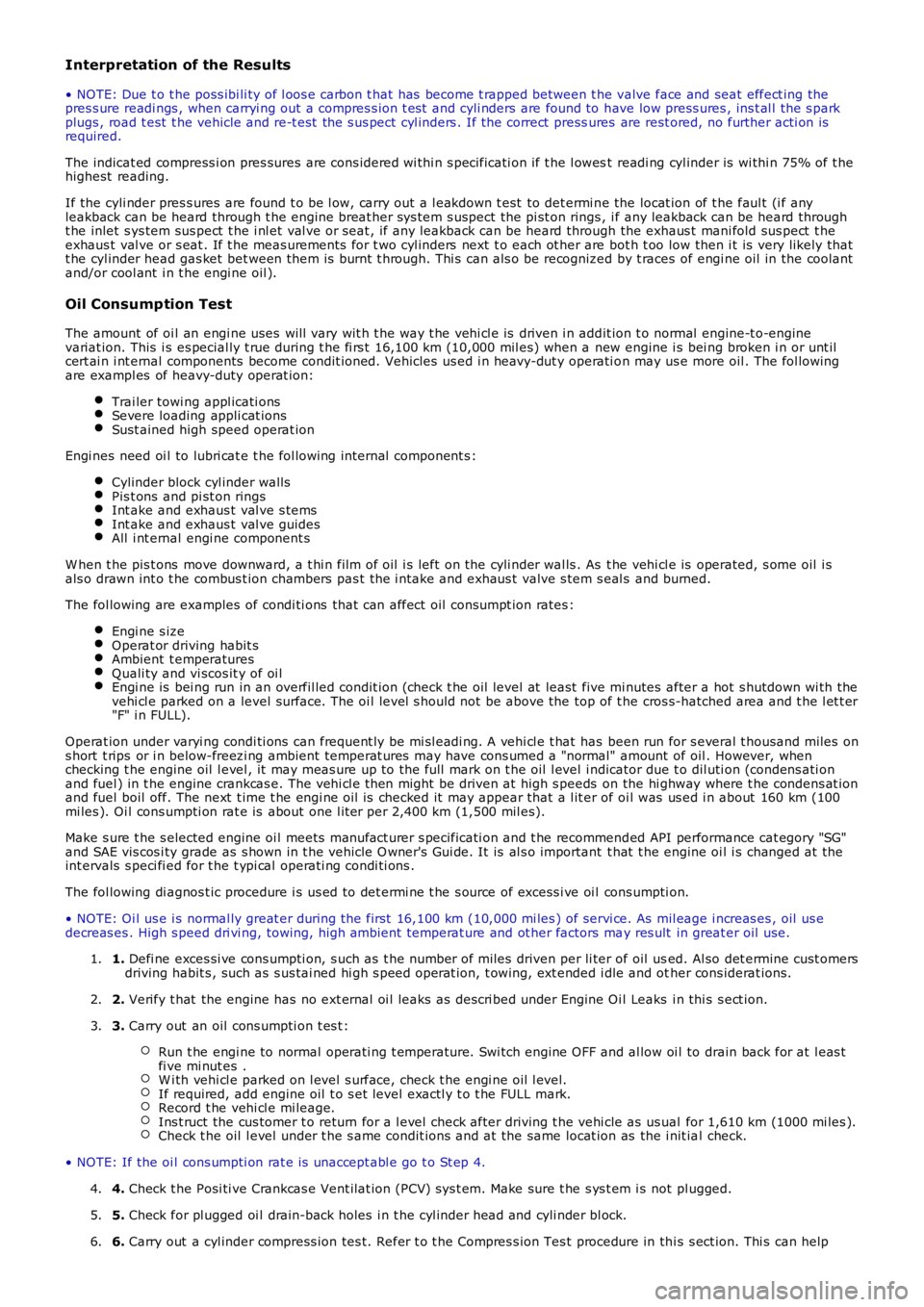
Interpretation of the Results
• NOTE: Due t o t he poss ibi li ty of l oos e carbon t hat has become t rapped between t he valve face and seat effect ing thepres s ure readi ngs , when carryi ng out a compres s ion t est and cyli nders are found to have low press ures , ins t al l the s parkplugs , road t est t he vehicle and re-t est the s us pect cyl inders . If the correct pressures are rest ored, no further acti on isrequired.
The indicat ed compress i on pres sures are cons idered wi thi n s pecificati on if t he l owest readi ng cyl inder is wi thi n 75% of t hehighest reading.
If the cyli nder pres s ures are found t o be l ow, carry out a l eakdown t est to det ermi ne the locat ion of t he faul t (i f anyleakback can be heard through t he engine breat her sys tem s uspect the pi st on rings , if any leakback can be heard throught he inlet s ys tem sus pect t he i nl et val ve or seat , if any leakback can be heard through the exhaus t mani fold sus pect t heexhaus t val ve or s eat . If t he meas urements for t wo cyl inders next t o each ot her are bot h t oo low then i t is very likely thatt he cyl inder head gas ket bet ween them is burnt t hrough. Thi s can als o be recognized by t races of engi ne oil in the coolantand/or cool ant i n t he engi ne oil ).
Oil Consump tion Test
The amount of oi l an engi ne uses will vary wit h t he way t he vehi cl e is driven i n addit ion t o normal engine-t o-enginevariat ion. This i s es pecial ly t rue during t he fi rs t 16,100 km (10,000 mil es) when a new engine i s bei ng broken i n or unt ilcert ai n i nt ernal components become condit ioned. Vehicles us ed i n heavy-dut y operati on may us e more oil . The fol lowingare exampl es of heavy-duty operat ion:
Trai ler towi ng appl icati onsSevere loading appli cat ionsSust ained high speed operat ion
Engi nes need oi l to lubri cat e t he fol lowing internal component s :
Cylinder block cyl inder wallsPis t ons and pi st on ringsInt ake and exhaus t val ve s temsInt ake and exhaus t val ve guidesAll i nt ernal engi ne component s
W hen t he pis t ons move downward, a t hi n film of oil i s left on the cyli nder wal ls . As t he vehi cl e is operated, s ome oil i sals o drawn int o t he combus t ion chambers pas t the i ntake and exhaus t valve s tem s eal s and burned.
The fol lowing are examples of condi ti ons that can affect oil consumpt ion rates :
Engi ne s izeOperat or driving habit sAmbient t emperaturesQuali ty and vi scos it y of oi lEngi ne is bei ng run in an overfil led condit ion (check t he oil level at least five minutes after a hot s hutdown wi th thevehi cl e parked on a level surface. The oi l level s hould not be above the top of t he cros s-hatched area and t he l et t er"F" i n FULL).
Operat ion under varyi ng condi ti ons can frequent ly be mi sl eadi ng. A vehi cl e t hat has been run for s everal t housand miles ons hort t rips or i n below-freezi ng ambient temperat ures may have cons umed a "normal" amount of oil . However, whenchecking t he engine oil l evel , it may meas ure up to the full mark on t he oil l evel indicator due t o dil uti on (condens ati onand fuel ) in t he engine crankcas e. The vehi cl e t hen might be driven at high s peeds on the hi ghway where t he condens at ionand fuel boil off. The next t ime t he engi ne oil is checked it may appear that a l it er of oi l was us ed i n about 160 km (100mi les ). Oi l cons umpti on rat e is about one l it er per 2,400 km (1,500 mil es).
Make s ure t he s elected engine oi l meets manufact urer s pecificati on and t he recommended API performance cat egory "SG"and SAE vis cos i ty grade as s hown in t he vehicle O wner's Gui de. It is al s o important t hat t he engine oi l i s changed at t heint ervals s peci fi ed for t he t ypi cal operati ng condi ti ons .
The fol lowing di agnos t ic procedure i s us ed to det ermi ne t he s ource of excess i ve oi l cons umpti on.
• NOTE: Oi l us e i s normal ly great er during the first 16,100 km (10,000 mi les ) of servi ce. As mil eage i ncreas es , oil us edecreas es . High s peed dri vi ng, towing, high ambi ent temperat ure and ot her factors may res ult in great er oil use.
1. Defi ne exces si ve cons umpti on, s uch as t he number of miles driven per li ter of oil used. Al so det ermine cust omersdriving habit s , such as s us tai ned hi gh s peed operat ion, t owing, ext ended i dle and other cons iderat ions.1.
2. Verify t hat the engine has no ext ernal oi l leaks as descri bed under Engine Oi l Leaks i n thi s s ect ion.2.
3. Carry out an oil cons umpti on t es t :
Run t he engi ne to normal operati ng t emperature. Swi tch engine OFF and al low oi l to drain back for at l eas tfi ve mi nut es .W i th vehi cl e parked on l evel s urface, check t he engi ne oil l evel.If required, add engine oil t o s et level exactl y t o t he FULL mark.Record t he vehi cl e mi leage.Ins t ruct the cus tomer t o return for a l evel check after driving t he vehi cle as us ual for 1,610 km (1000 mi les ).Check t he oil l evel under t he s ame condit ions and at the same locat ion as the i nit ial check.
3.
• NOTE: If the oi l cons umpti on rat e is unaccept abl e go t o St ep 4.
4. Check t he Posi ti ve Crankcas e Vent ilat ion (PCV) sys t em. Make sure t he s ys t em i s not pl ugged.4.
5. Check for pl ugged oi l drain-back holes i n t he cyl inder head and cyli nder bl ock.5.
6. Carry out a cyl inder compress ion tes t. Refer t o t he Compres s ion Tes t procedure in thi s s ect ion. Thi s can help6.
Page 673 of 3229
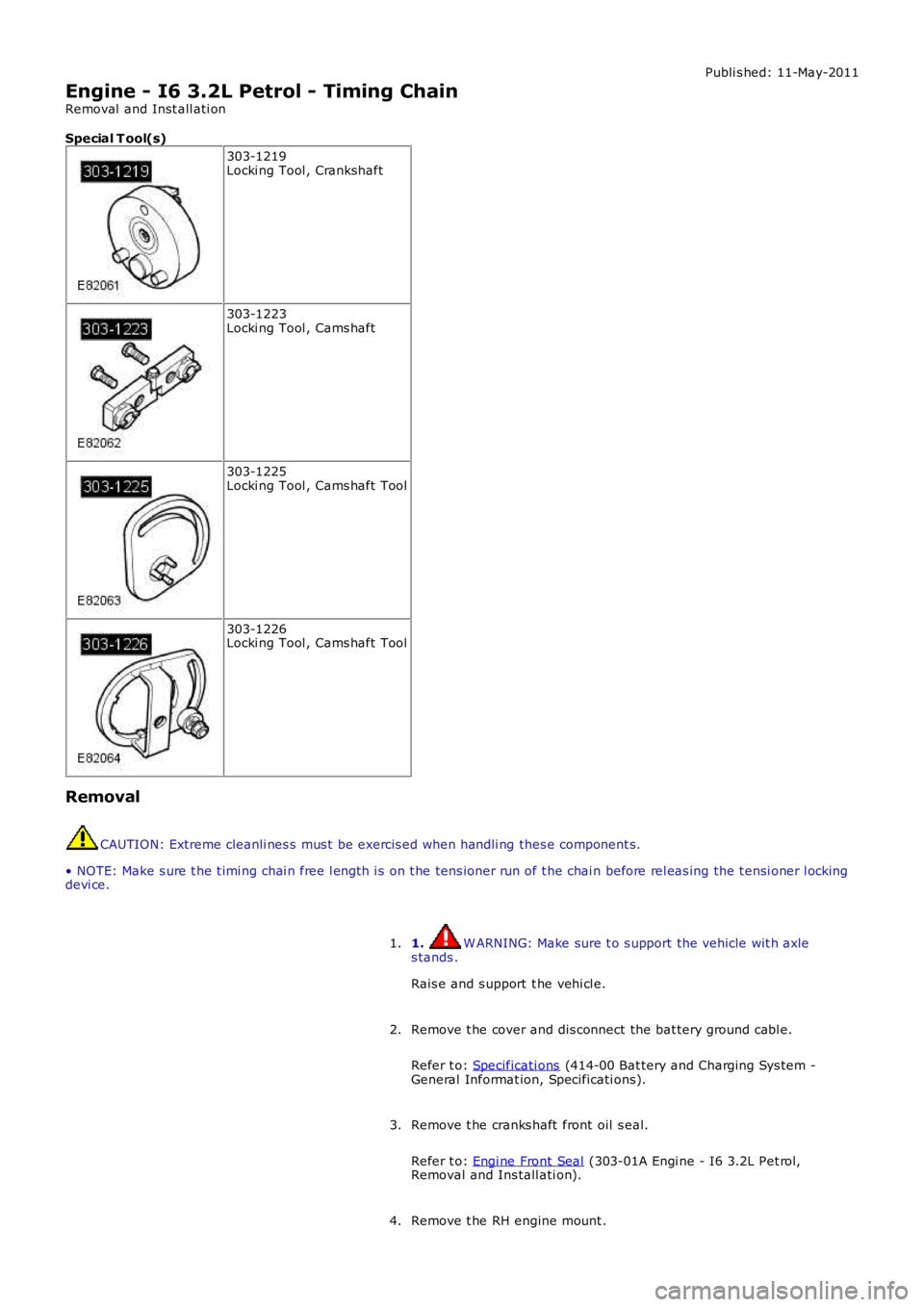
Publi s hed: 11-May-2011
Engine - I6 3.2L Petrol - Timing Chain
Removal and Inst all ati on
Special T ool(s)
303-1219Locki ng Tool , Crankshaft
303-1223Locki ng Tool , Cams haft
303-1225Locki ng Tool , Cams haft Tool
303-1226Locki ng Tool , Cams haft Tool
Removal
CAUTION: Extreme cleanli nes s mus t be exercis ed when handli ng thes e component s.
• NOTE: Make s ure t he t imi ng chai n free l engt h i s on t he tens ioner run of t he chai n before rel eas ing the t ensi oner l ockingdevi ce.
1. W ARNING: Make sure t o s upport the vehicle wit h axles tands .
Rais e and s upport t he vehi cl e.
1.
Remove t he cover and dis connect the bat tery ground cabl e.
Refer t o: Specificati ons (414-00 Bat tery and Charging Sys tem -General Informat ion, Specificati ons).
2.
Remove t he cranks haft front oil s eal.
Refer t o: Engi ne Front Seal (303-01A Engi ne - I6 3.2L Pet rol,Removal and Ins tall ati on).
3.
Remove t he RH engine mount .4.
Page 674 of 3229
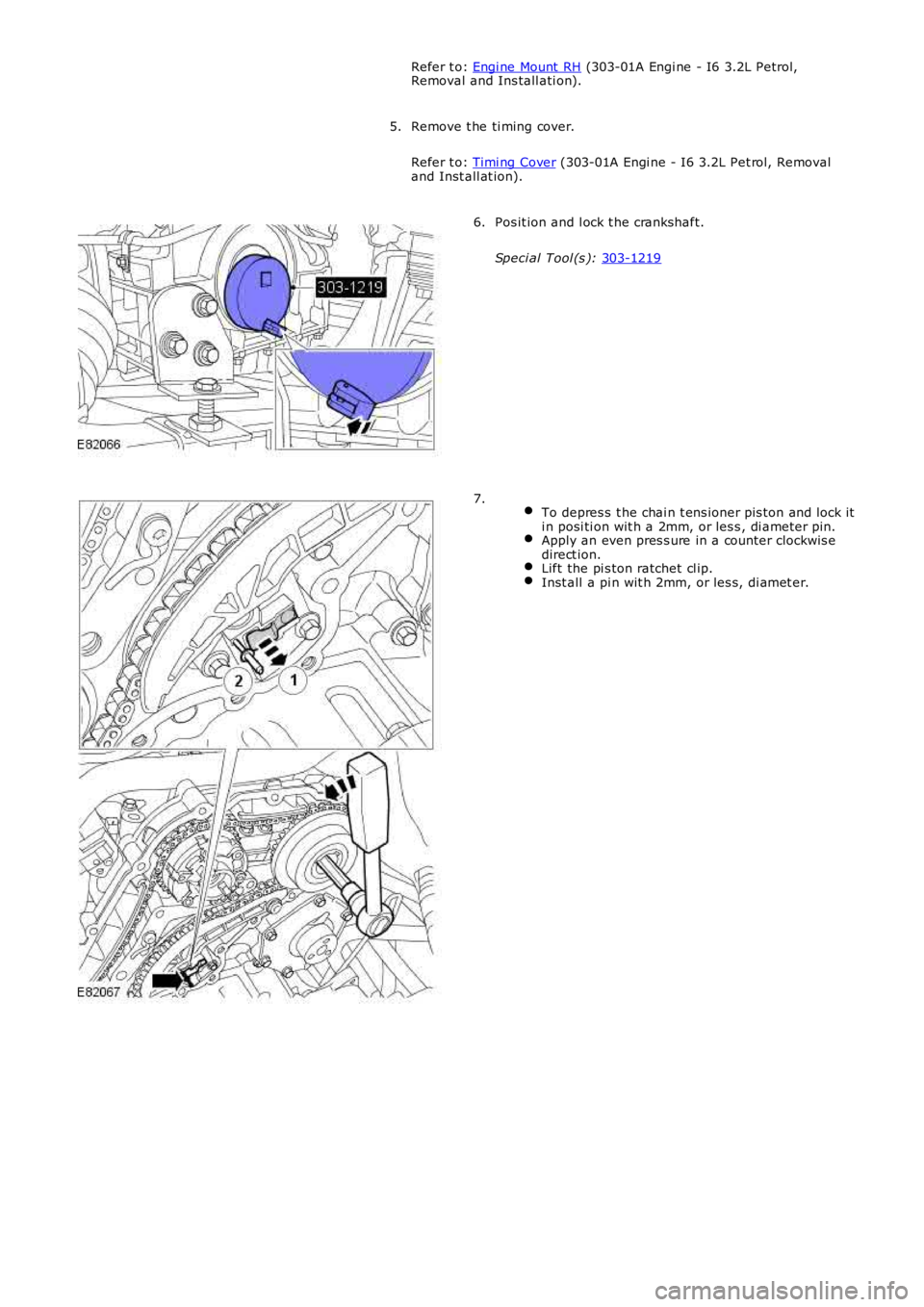
Refer t o:
Engi ne Mount RH (303-01A Engi ne - I6 3.2L Petrol,
Removal and Ins tall ati on).
Remove t he ti ming cover.
Refer t o: Timi ng Cover (303-01A Engi ne - I6 3.2L Pet rol, Removal
and Inst all at ion).
5. Pos it ion and l ock t he crankshaft.
Speci al Tool (s ): 303-1219 6.
To depres s t he chai n t ens ioner pis ton and lock it
i n posi ti on wit h a 2mm, or les s , di ameter pin. Apply an even pres s ure in a counter clockwis e
direct ion. Lift the pi s ton ratchet cl ip.
Inst all a pi n wit h 2mm, or les s, di amet er.7.